There’s just something extra special about a backdrop of bubbling lava, snapping tentacles, poisonous forests, sinkholes, cracking ice, an unbreathable atmosphere, or the approach of a blistering sunrise that amps up the excitement factor. The story was probably already pretty good, but now everyone might die on the way to wherever they’re going. And they might die horribly because someone thought it was a good idea to visit Paradise Not.
That someone could easily be me. I have a habit of putting my characters in horrible places and I’m going to place the blame on some of my favorite books and movies. We’ll start with Ursula K. Le Guin, who is known for testing every limit her characters have—and then some…
The Left Hand of Darkness by Ursula K. Le Guin
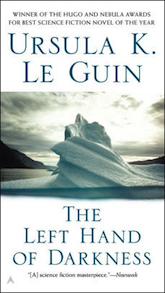 This is not the first book of Le Guin’s I ever read, but the one I remember the best. I find the themes of gender identity refreshingly challenging. But when I talk about The Left Hand of Darkness, I usually end up describing the part where Genly and Estraven spend eighty days traversing the northern Gobrin ice sheet. The environment is unspeakably harsh and Le Guin makes it enthralling. I could feel the fat melting away from Genly and Estraven as they balanced their daily calorie expense against necessary exertion. I shivered when I learned that it doesn’t snow when the temperature drops below a certain threshold. I didn’t ever want to know how cold that must be.
This is not the first book of Le Guin’s I ever read, but the one I remember the best. I find the themes of gender identity refreshingly challenging. But when I talk about The Left Hand of Darkness, I usually end up describing the part where Genly and Estraven spend eighty days traversing the northern Gobrin ice sheet. The environment is unspeakably harsh and Le Guin makes it enthralling. I could feel the fat melting away from Genly and Estraven as they balanced their daily calorie expense against necessary exertion. I shivered when I learned that it doesn’t snow when the temperature drops below a certain threshold. I didn’t ever want to know how cold that must be.
Not lost on me was the fact that the beyond bitter cold was the backdrop for the most important part of the book—Genly and Estraven learning to trust each other. It’s similar to putting two adversaries in a remote cabin with only one way in and one way out—and blocking that entrance with a grizzly. Makes a good argument for even a temporary truce, doesn’t it?
The Chronicles of Riddick
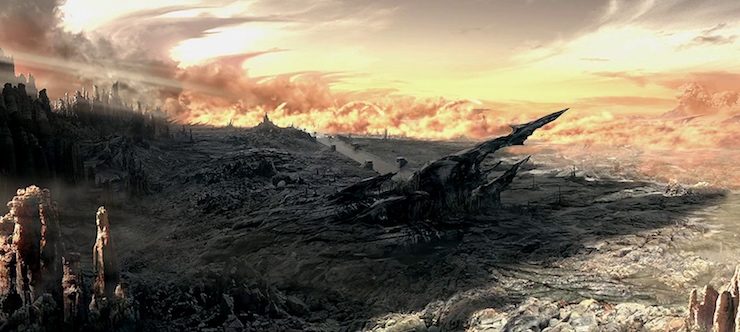
On the opposite end of the spectrum, we have Crematoria! I love this planet and not just because of the suggestion that about five hundred years in the future we’ll still be claiming the best real estate for prisons—in this case, a planet that will freeze your behind by night, only to roast it in the morning. If someone were able to escape the triple max prison buried deep beneath the surface of this abused planet, they’d probably die pretty quickly.
But not Richard Riddick. He and and an old friend plot their escape during the brief window between night and day. As if the terrain weren’t enough—smoking pits of… smoke, crumbling cliffs, falling ash—the sun is rising. The effect is awesome, like a spirograph of light on the far horizon. I won’t spoil the rest, except to note that the highlight of the movie, for me, is when half the party gets stuck by the advancing line of daylight and fiery plumes of lava.
2312 by Kim Stanley Robinson
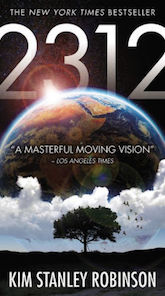 I love to hike and have aspirations of one day completing more than a single span of the Appalachian Trail. If we had an outpost on Mercury—either underground, or rolling across the surface in advance of the sun as depicted in Kim Stanley Robinson’s novel 2312—I’d probably want to hike there. The book begins with a tantalizing invitation:
I love to hike and have aspirations of one day completing more than a single span of the Appalachian Trail. If we had an outpost on Mercury—either underground, or rolling across the surface in advance of the sun as depicted in Kim Stanley Robinson’s novel 2312—I’d probably want to hike there. The book begins with a tantalizing invitation:
The sun is always about to rise. Mercury rotates so slowly that you can walk fast enough over the rocky surface to stay ahead of the dawn; and so many people do. Many have made this a way of life. They walk roughly westward, staying always ahead of the stupendous day.
Robinson goes on to detail how some walkers dally in certain locations to watch the sun spread across the horizon behind them, some so in awe of the spectacle that they almost forget to run farther westward in time to outpace the dawn. There’s also a city called Terminus that rolls around the planet on a train—always ahead of the sun. One of my favorite adventures actually takes place beneath the tracks as Swan takes shelter from the sun only to be trapped for weeks in underground tunnels. Do I need to mention that I’m also fond of perilous journeys?
Master Sergeant by Mel Odom
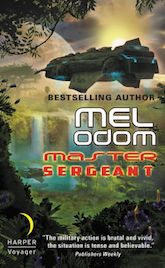 In Master Sergeant, Mel Odom introduces us to Makaum, otherwise known as the Green Hell. The planet is a maze of vicious vegetation defying every effort at containment. Like the burning sun and endless ice I’ve mentioned above, the jungle is inimitable, and it shapes the entire culture of the planet. It cannot be beaten back, but only be controlled for short periods of time, say for the purpose of clearing a landing pad. It’s a horrific and oppressive environment that leaves you wondering why anyone would want to live there.
In Master Sergeant, Mel Odom introduces us to Makaum, otherwise known as the Green Hell. The planet is a maze of vicious vegetation defying every effort at containment. Like the burning sun and endless ice I’ve mentioned above, the jungle is inimitable, and it shapes the entire culture of the planet. It cannot be beaten back, but only be controlled for short periods of time, say for the purpose of clearing a landing pad. It’s a horrific and oppressive environment that leaves you wondering why anyone would want to live there.
Turns out, the planet is rich in natural resources. Of course it is! This is science fiction at its best. Why put the most sought after mineral in the galaxy on a barren rock where anyone can get at it when you can bury it beneath a man-eating jungle on a planet also infested with drug runners and gangs? Seriously.
Master Sergeant is military science fiction, which I also love, and outside the superlative world building also tells a great story. Inclusion on this list, though, is down to the jungle. Imagine a world where you can’t walk a foot without bumping into herbicide and fire resistant poison ivy? Lots of it. Then make it carnivorous. Further imagine how an environment like that would shape your life? I want to write that book. I have notes for that book.
Interstellar
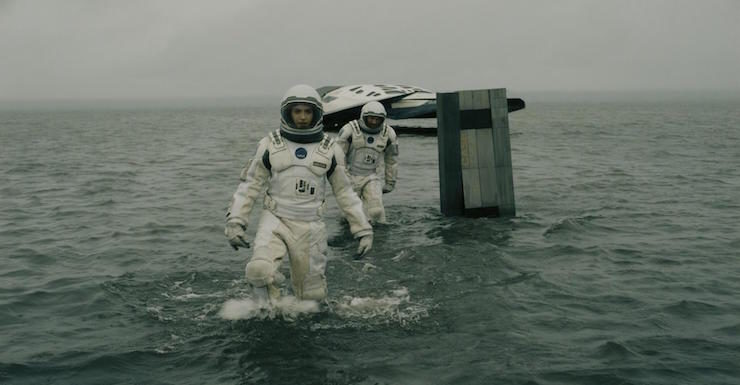
Lastly, let’s talk about Miller’s Planet from the movie Interstellar. Without giving too much away—it’s not a viable choice for colonization. The why of it is what makes it so fascinating, though. Not only is there a severe time dilation effect, meaning that time passes more slowly on the surface than it does outside orbit, but the place is literally one big ocean… and the black hole hovering over the horizon means there are some wicked tides. (The black hole also responsible for the time thing.)
There is land at the bottom of the sea, but both will disappear when the next wave hurtles past—at the height of Mount Everest. Disastrous and not particularly welcoming, but fascinating nonetheless. Ever since seeing the movie, I’ve pondered ways in which such a planet could be made habitable. I’ll let you know if I come up with something.
So, are you ready to visit Paradise Not? Inhospitable environments occur frequently in all forms of fiction—and in our own world—inspiring some of the greatest stories of people surviving against all odds, emerging perhaps damaged, always deeply affected, but also stronger and with greater resolve. These settings are often the ultimate test, and that’s why I love them so much.
 If aliens ever do land on Earth, Kelly Jensen will not be prepared, despite having read over a hundred stories of the apocalypse. Still, she will pack her precious books into a box and carry them with her as she strives to survive. It’s what bibliophiles do. Kelly is the author of a number of novels, novellas and short stories, including the Chaos Station series, co-written with Jenn Burke. Her latest release is To See the Sun, a queer SFF Romance featuring two men looking for a place to finally call home and finding it on an inhospitable planet on the edge of the galaxy. You can find her on Twitter @kmkjensen.
If aliens ever do land on Earth, Kelly Jensen will not be prepared, despite having read over a hundred stories of the apocalypse. Still, she will pack her precious books into a box and carry them with her as she strives to survive. It’s what bibliophiles do. Kelly is the author of a number of novels, novellas and short stories, including the Chaos Station series, co-written with Jenn Burke. Her latest release is To See the Sun, a queer SFF Romance featuring two men looking for a place to finally call home and finding it on an inhospitable planet on the edge of the galaxy. You can find her on Twitter @kmkjensen.










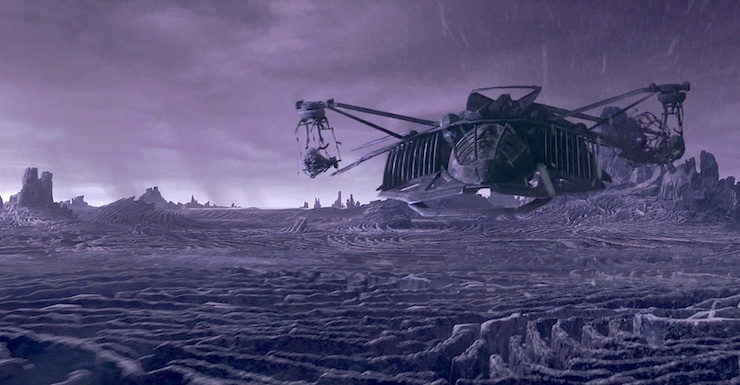
Obviously Dune, and at the opposite end of the spectrum there’s Alan Dean Foster’s ice planet of Tran Ky Ky. MidWorld, unsurprisingly, being in the middle (climatologically).
Fenris, the Four Day Planet, is pretty darn inhospitable, with it’s own adventure on the ice. The book by H. Beam Piper is available on Gutenberg.
Harry Harrison’s Deathworld was arguably intended as the ultimate example.
Most of Hal Clement’s worlds would kill unprotected humans, including in one case Earth itself.
@2,
Although the real danger in Harry Harrison’s Deathworld is the people, not the planet.
Roshar (from The Stormlight Archive) jumps out at me. Severe storms that destroy everything not made of stone on a routine basis make for a very inhospitable planet.
Don’t forget Venus. I suppose it’s just lethal instead of inhospitable.
Star Wars is full of inhospitable planets: Hoth, Tatooine, Kessel, that lava planet, etc.
I wonder if inhospitability correlates with single biome planets. Earth is hospitable because we’ve got so many options of environments to live in. Take just one and make it the whole planet and it’s not surprising it’s not as nice a place to live.
@5 All hurricane season all the time!
We Made It from Niven’s Known Space, where severe winds make the surface unhabitable. The winds are also the main reason their capital is called Crashlanding City.
Also Beta from Vorkosiverse, but I think the main problem there is surface temperature.
And there is also Pyrrus aka the original Deathworld, a living hell where every plant and animal have the single purpose of killing humans. But the reason for it is a spoiler.
What about Arrakis? A desert world so inhospitable that the need for water shapes an entire culture? Dune revolves around Arrakis being basically Hell-on-sand.
I always found the Venus of Ray Bradbury’s The Long Rain an interesting case, as that version of the planet is technically habitable in a physical sense but so psychologically inhospitable outside of the Sun Domes.
@8,
Arrakis. “Oh you who know what we suffer here, do not forget us in your prayers.”
Also Cat’s Cradle, post Ice-9.
Gethen isn’t that inhospitable overall, it’s just a version of Earth’s most recent ice age. The action just happens to start in the local equivalent of Trondheim, and move to an attempt to get to Anchorage over the North Pole.
Did the makers of Interstellar say why the planet wouldn’t become tide-locked on the black hole?
One of Forward’s books had a pair of close orbiting worlds that would from time to time exchange significant quantities of volatiles, including what i remember as most of an ocean.
Rosemary Kirstein’s Steerswoman books are set on a world where outside a province-sized region the biochemistry is inedible by humans.
Roshar jumped to my mind, too. Brandon Sanderson has a flair for uniquely hostile worlds, filling his Cosmere galaxy with the likes of Taldain’s eternal day and incessant night, Scadrial’s era of mist and constant volcanic ashfalls, the extremely dangerous wildlife on First of the Sun, the equally dangerous spirit-shades on Threnody, and more. But Roshar is one of the most complex and extensively-described to date.
@12:
Rocheworld, yes, entertaining book. And it’s not really MOST of the ocean, but it’s enough to be surprising. That book has very interesting aliens.
So does his _Dragon’s Egg_ – given that it’s set on a neutron star, I guess that qualifies as inhospitable :).
Also on the strange biology/biochemistry front, Niven/Pournelle/Barnes’s _Legacy of Beowulf_ has a world with an odd-but-unfriendly biology, and Niven’s _Destiny’s Road_ also has a world with *almost* human-compatible biochemistry.
Let us not forget Ceti Alpha V from Star Trek II. A desert waste with brain-burrowing beasties to boot!
Another hurricane planet is that in Cordwainer Smith’s _On the Storm Planet_.
That one even had air whales – Sharknado had nothing on it!
Hal Clement’s Mesklin is among the most memorable planets I have ever visited through fiction. And, while Pluto appears in a fair amount of fiction, the short trip on its surface described by Heinlein in Have Spacesuit Will Travel ranks up there among the most evocative passages I have ever read.
In Paul Goodwin’s The Survivors, hostile aliens called the Gern hijack a human colony ship and dump the people onto a death planet. High gravity, full of fierce predators, aptly named Ragnarök. The die off is fierce. Despite everything they can do, the weak go to the wall. “He found that the prowlers had killed seventy during the night. One hundred more had died from the Hell Fever that often followed exposure and killed within an hour.”
Over the generations the colonists get stronger, faster, smarter, until they become the apex predator. When the Gern return, they expect a walkover conquest. A harvest of slaves to be used up in bad conditions. It didn’t quite work that way.
http://hell.pl/szymon/Baen/The%20Baltic%20War/The%20Cold%20Equations/0743436016___1.htm
Does anyone remember a very old TV show or movie with a planet that became lethal when the sun came up? There was vegetation that looked kind of like sea sponges or coral, and my memory wants to tell me it became electrified in the light. I saw it once as a kid in the 80s and have some solid images left in my head, but no certainty for what it was. It might have been “Planet of Light” from the marionette show Space Patrol (Planet Patrol) – the description sounds promising but I haven’t seen it since to be sure.
2 things:
1) the picture at the top is not from Chronicles of Riddick. Its from Riddick, the sequel of sorts to Chronicles.
2) Crematoria may be cool and all, but how does it have a breathable atmosphere?
@3 It would appear from what we’ve been learning for the past several years about exoplanets is that we may be living in Hal Clement’s universe after all.
@6, the more biomes you have, the more you have to convince the reader they’re all inhospitable, and the harder you have to work to ensure the boundaries are inhospitable too. Unless you’re okay with a hospitable boundary, but only the boundary.
But then it’s harder to feel any sympathy: “Woe is us, our planet is half desert and half ice, only a strip the size of Chile is comfortable!” Dude, you own a comfortable country the size of Chile, what’s your problem?
Arrakis has a half-comfortable spot around one pole. Leaving aside the spoiler about the other hemisphere, that’s more plausible as a marginally-hospitable planet, because you can put the pressure on even the pole to be on the point of being too hot.
@22 If the boundary is comfortable then you can be sure all the interesting stuff is in the death zone. Though it’s cheating a little to give your characters a safe place to start from
@3. James Davis Nicoll, I’ll second you on Hal Clement. The book Iceworld has an alien drug agent, forced by smugglers to work on a horribly cold planet where the gas he breaths, sulfur, is frozen into a hard yellow solid. Now, that is a hostile planet. The aliens have a base on the barely habitable planet of Mercury.
@20 RE your #1: That’s what I was thinking…thanks for the confirmation!
Hades, or Hell, in Weber’s Honor Harrington series. It’s a gorgeous place, lush and warm–ranging from yeah-actually-too-lush-and-warm on the equator to a kind of mega-Hawaii up in the north. The Honorverse being gifted with cheap star travel, it’s also the POW holding area for a multi-star-system polity that’s been at war with one neighbor or another for decades. That’s because everything in the spectacularly beautiful scenery is unfit for human consumption, and the soil cannot be used for farming without terraforming. Only the mega-Hawaii has been terraformed. Slave laborers there produce food for rustic camps scattered all over the planet; shuttles deliver fresh food on a regular schedule. If a camp rises up and tries to take a shuttle…that camp is taken off the roster for a while. And the inmates get to starve amid picture-postcard beauty.
@26 If we’re going into the Honor-verse, there’s also Grayson, which is a quite lovely planet with enough heavy metals to poison you in short order. Or there’s than Andermani planet with the chlorophyll-eating bacteria (or whatever).
A famous grand-daddy of inhospitable planets – Solaris, by Stanislaw Lem. This is the most famous of his works outside Poland, likely due to the two movie adaptations. A later novel of his also dealt with an uncommunicative alien population, Fiasco.
Does Bladerunner count?
Perhaps we need to distinguish natural hells from man-made ones.
Given the popularity of Kevin J. Anderson (I don’t get it myself [shrug]) I’m surprised no one has mentioned the Hellhole trilogy he co-wrote with Brian Herbert. It doesn’t have volcanoes. it doesn’t have glaciers. It has massive earthquakes and acid geysers and an ecology that reads like the entire list of dangerous Australian animals got doused in toxic waste and mutated. And then the alien problem started cropping up …
Despite KJA’s trailing ellipses … I really enjoyed it. My only wish was that they had just made all the flashbacks into volume 1 instead.
The planet Marduk, in David Weber and John Ringo’s Empire of Man series. It’s a warm hell with more nasty predators than you can shake a blaster at. Crossing the continent involves a high body count among the toughest military force in the universe; a Battalion of the Empresses Own Guard. Marduk features in the first two books, The March Upcountry and The March to the Sea.
None of the books are named Anabasis.
Another candidate for the planets with an eternally moving firefront is the final destination of Iain M Banks Player Of Games.
The various planets in Interstellar were one of many things that didn’t make sense about that terrible film. (Frozen clouds. In the sky. Frozen clouds. Hasn’t this guy ever heard of snow?)
If the constantly-moving wave on Miller’s World is the result of it being near a black hole, then it isn’t a wave, really; it’s the tidal bulge. In which case that planet is spinning really very fast, with one high tide every couple of hours. And they’re the wrong shape for tidal bulges; they look more like breaking waves. Even tsunami don’t look like breaking waves. And tides don’t go low tide…low tide…low tide… low tide… SUDDENLY HIGH TIDE ALL AT ONCE! Hasn’t this guy ever been to the seaside?
If they’d done it as a fantasy film, like Star Wars, I wouldn’t have minded. (“Light sabers couldn’t work because you’d burn yourself from the radiated heat!” NO ONE CARES.) But they made such a song and dance about how it was all so realistic and Kip-Thorne-approved, and it was all a sham.
For inhospitable planets… Pluto, as represented in Larry Niven’s World of Ptavvs. The atmosphere has all frozen out, you see, and settled in layers of different gases according to freezing point. So it’s an inert iceball until you start to land, then the heat of your rocket exhaust melts through the solid oxygen layer… and into the solid hydrogen layer. And then the entire planet explodes. (He did note later that he’d hate to defend the idea of an explodable Pluto today, given advances in planetology… but it’s an excellent plot device.)
ajay @@@@@ 33:
Hasn’t this guy ever been to the seaside?
For what it’s worth, Kip Thorne apparently has some handwaving for some of the “waves on MIller’s planet” issue. Specifically, Miller’s planet is assumed to be tidally locked to the supermassive black hole, but with a residual back-and-forth oscillation; it’s the latter that gives you recurrent passage through the ocean’s tidal bulge, and thus the effect of recurrent “waves”. Thorne says that
(From this discussion on physics.stackexchange.)
Echoing @3, 17, and 24. I read Clement’s Mission of Gravity 40+ years ago, but it came to mind instantly.
Venus as depicted in STanley G. Weinbaum’s stories….
@16 – How about the original storm planet, Trenco from E. E. Smith’s Lensman series. 47 feet of “rain” every night. 800 mile an hour gales every day. And yet it’s a popular destination as the most powerful drug in the universe is only found there.
How about the planet from David Drakes Redliners. A planet bio-engineered to kill you and then adapts so you always on guard. Very hard to survive when the plants are trying to kill you.
My first thought was Riddick, glad to see it’s awesomeness highlighted.
My next thought was the Hyperion series.. I can’t recall which book, but I loved the description of the river portals taking them to other planets, some of which were quite inhospitable.. Will have to re-read and find the details.
Hard to believe no one has mentioned Cordwainer Smith’s A Planet Named Shayol.
Roger Zelazny has a short story called “The Keys to December” which tells the story of terraforming a planet to slowly make it habitable to a mutant race of humans created to work in freezing mines which were no longer necessary. It’s a fascinating story of concept of “habitability” understood in a cultural sense.
I’m surprised no one has mentioned Hoth. Your tauntaun will freeze before you hit the first marker!
Niflheim in H. Beam Piper’s “Uller Uprising”. Its atmosphere has gaseous fluorine in it so environment suits and vehicles have to be very corrosion resistant. It has no ecology, no life as anyone knows it. Thus it’s fine to jump start volcanoes with nuclear bombs in order to have lava spew out valuable metals etc. Faster and easier than digging deep to mine for stuff.
Of course they’re not using plain old uranium bombs, or even plutonium. Those antiques haven’t been used for over 450 years. But along comes a situation wherein an old-school A-Bomb is precisely what’s required.
Best line from the book? “We’re running a gaseous diffusion process to separate the nuclear physics from the pornography.” If that makes you think “WTH?” you’ll just have to read the book. ;)
+1 for Niven’s ability to invent worlds with inhospitable locales, from Mount Lookithat (a planet with a single habitable mountain that protrudes from the constant cloud cover), Jinx ( a planet with gravity over 1.5 times that of earth which is only habitable in a narrow band, with the poles extending out of the atmosphere, and an equator that has such a heavy atmosphere, that you can only visit in a tank ( to hunt Bandersnatch) and my favourite, the planet from “Bordered in Black” where the indigenous humanoids have evolved based on the environment (any more would give away the ending). He also wrote a story “Flare Time” that had the environment totally change when there was a solar flare.
Spatterjay.
Neal Asher.
Pern comes to mind. Have to love a world where clingfire falls from the sky and burns through everything!
The far-future Earth of N.K. Jemisin’s “Broken Earth” trilogy. Truly a hostile planet, and can you blame him?
@1, @44, I just want to reinforce the Piper love here, my favorite sci-fi author.
And Niflheim is used as a swear in later books like Junkyard Planet (which itself isn’t too bad a place to live).
Hullmetal Girls (reviewed elsewhere on tor dot com) has the probably necessary to the story the author wants to tell detail that within the category of most-Earthlike-worlds-known, none have breathable atmospheres. Which makes sense, given that Earth for most of its history was uninhabitable by humans.
Two more that no one has mentioned yet: Frank Herbert’s Pandora, from The Jesus Incident; flora and fauna to die for, literally.
And Hydros, from Robert Silverberg’s The Face of the Waters. There were admittedly a couple of habitable islands on this one. But the rest of the planet was water. And once the humans were banished from the islands, they found that literally everything in the sea was trying to kill them, often quite nastily.
Granted, it’s been twenty years since I read these, but the topic brought them springing to mind.
And one that I haven’t read yet, but fully intend to: Take Back Plenty by Colin Greenland; Venus again.
Smile.
*acquires The Face of the Waters audiobook*
My two-penn’th – Brian Aldiss’ Helliconia trilogy.
@41, you beat me to it.
@53, Cordwainer Smith had some other pretty hellish places, like Pontipidian, where the gift of a potted plant was literally more valuable than rubies
@20, your #2. You’re right, oxygen, as far as we know, requires plant life to create and sustain.
Knowing what I do about planetary and atmospheric development, the most logical assumption is that Crematoria was once a normal planet (abundant with life and an oxygenated atmosphere) which then went rogue fairly recently, and was captured by its current star at very close proximity, whereupon all the life perished but the oxygen remained. They then built a prison which uses said store of oxygen, and would be able to continue doing so for millions of years since there are only a handful of people there.
In fact the atmosphere would probably be stripped off by the solar wind far sooner than any number of people can breath it.
The problem is, with the amount of heat absorbed during daytime and the thickness of the atmosphere (Earth-similar), you would never be able to disspate the heat during nighttime.
Still, it doesn’t detract from my SF movie of the decade. Dagum I love that movie!
The Warden Diamond.
Stanislaw Lem’s Solaris is not too hospitable. Poisonous atmosphere, global semi-organic ocean that is lifeless except for being “alive” (maybe) itself. And it studies your psyche and bedevils you with psychological experiments by dint of being haunted by deceased loved ones.
There was a story I read a very long time ago where the planet was nice and comfy but the colonists started dying when they started eating locally grown and native flora. The planet was high in beryllium, and the plants would concentrate it. The local fauna was fine with Be in the diet; humans were not.
Sometimes, it’s the subtle things that kill you.